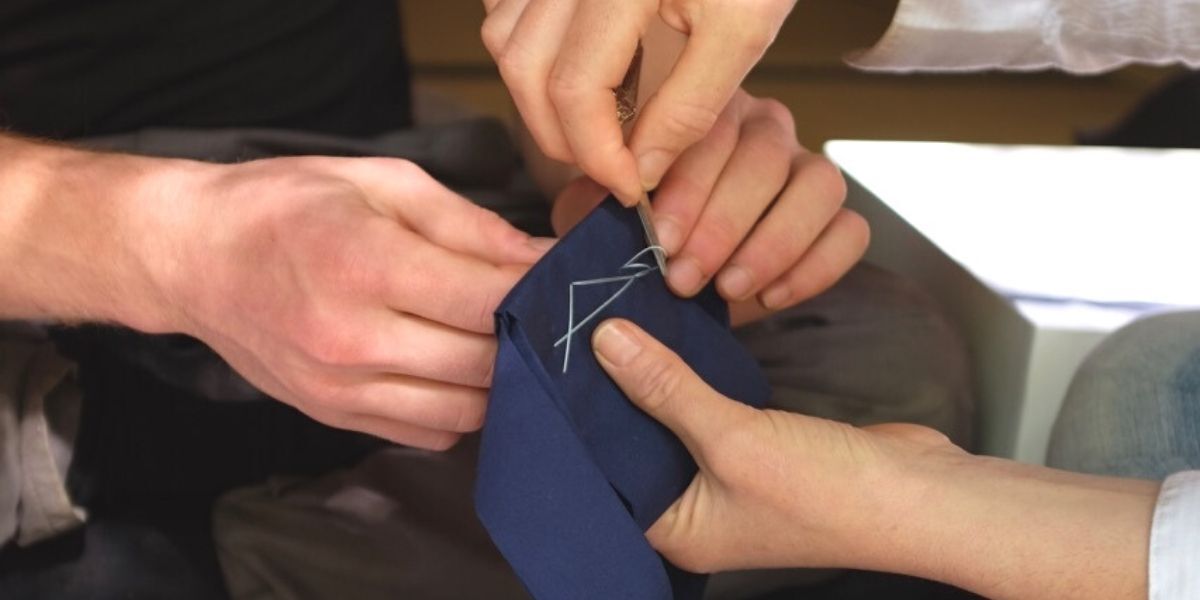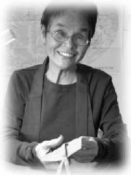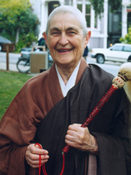
By Tova Green
The Zen Buddhist Sewing Teachers and Everyday Zen launched a six-month non-residential online practice period in June 2021, called Sewing with Heart. Seventy sewing teachers and apprentices from the U.S., Canada, Britain, Ireland, Germany, Italy, and Russia are participating in this unique offering.
The inspiration for the practice period came from Shosan Victoria Austin, who wanted to honor the fifth anniversary of Zenkei Blanche Hartman’s death on May 13, 2016. Because of the uncertainties of the Covid-19 pandemic, Shosan realized that she couldn’t plan a large in-person gathering to celebrate Blanche’s life and teaching, and decided to put together an online practice period to honor Blanche’s many years as the SFZC sewing teacher.
Shosan describes sewing Buddha’s robe as a work practice, a form of service to the sangha. Suzuki Roshi said in a talk he gave in June 1971, “We do not make our robe just for ourselves. We are making something greater, which will include everything, which could be everyone’s.”
Sewing Buddha’s Robe, or Nyoho-e (translated literally as the clothing of Dharma suchness) is a tradition that goes back to the time of the Buddha. In the early days of San Francisco Zen Center, Suzuki Roshi invited Yoshida Roshi to come from Japan to teach sewing. Later, Richard Baker invited Joshin-san, who had trained at Antaiji, to be the Zen Center sewing teacher. Yoshida Roshi and Joshin-san represent two traditions of sewing. Yoshida Roshi passed her method on to Tomoe Katagiri in Minnesota, and Joshin-san trained Blanche Hartman.
When the Zen Buddhist Sewing Teachers Association was founded in 2012, one of its goals was to fulfill Blanche’s request that we keep sewing practice alive and connect sewing teachers in both traditions.
The six-month Sewing with Heart practice period is divided into three sections, each two months long: a historical focus, acknowledging the heart of the Nyoho-e tradition, including stories about Blanche and Tomoe-san; learning about how this tradition is transmitted through time and space; and exploring the legacy of Nyoho-e, how to transmit the heart of Nyoho-e to future generations.
Shosan created leadership roles for the practice period similar to leadership roles in residential practice, including a senior guest teacher, or “outside teacher” (godo), head of practice (tanto), head student (shuso), and senior staff positions—director, treasurer, head of the meditation hall (ino), guest manager (shika), and work leader. These positions are filled by sewing teachers from both Tomoe’s and Blanche’s traditions. All the participants are teaching sewing or being trained to do so. All have received jukai (lay ordination); some are priests, some Dharma-transmitted, and want to assist sewing students.
The godo for this Nyoho-e practice period is Sokaku Kathie Fischer, a Dharma sister of Shosan’s. Both received Dharma transmission from Sojun Mel Weitsman, deceased former abbot of Berkeley Zen Center. The godo’s role is to share her perspective on the dharma.

Tomoe Katagiri
Shosan invited Jean Selkirk, Berkeley Zen Center’s sewing teacher and compiler of the booklet Buddha’s Robe Is Sewn: The Tradition of Sewing Practice in the Shunryu Suzuki-roshi American Lineage, to be the shuso (head student). Being shuso in a practice period is an important rite of passage in Zen training, both for priests and lay leaders. The shuso traditionally gives their first Dharma talks and has tea with all the practice period participants as part of their preparation for being a practice leader.
Jean commented that several years ago she began asking how teaching sewing could become a legitimate path of practice. Could there be recognition of the ways in which sewing teachers support the practice of people receiving the precepts, ordaining as priests, or receiving Dharma transmission? “Sewing teachers set the tone of the sewing room, creating a space in which students can focus, concentrate, and settle into their sewing. They also must be alert to the challenges students have with their sewing. The hardest thing of all can be learning to love your own stitches,” she said.
During this practice period Jean will give two talks and twenty-two teas, as well as participating in small group discussions focusing on what a sewing teacher needs to know, and what we know about sewing practice and how to make that accessible.

Zenkei Blanche Hartman by Barbara Wenger
Gengyoko Tim Wicks, the tanto, is the head teacher in the City Center sewing room and the President of Zen Buddhist Sewing Teachers. He studied with Blanche Hartman during the last ten years of her life and learned her inclusive practice of helping everyone who comes to the sewing room. Tim is “trying to be of service to participants, assisting them in their practice.”
Tim notes that “This is a Covid practice period, entirely virtual, without a home temple or monastery.” Some participants are new to the Slack platform and other technical aspects of online learning. They are participating from different time zones. These factors add to the stress of emerging from the pandemic; some participants are experiencing anxiety. Normally classes and small groups would make it easier for people to meet and connect with each other. In this practice period people are not sitting together or eating meals together. Nevertheless, Tim appreciates the pioneering nature of this practice period and the patience and perseverance of participants.
Paula Pietranera, one of Tim’s sewing apprentices, is providing general support for the practice period. Although much of her work is behind the scenes, her steady presence is “the glue that keeps the practice period functioning well,” according to Tim.
Teachers and participants meet every three weeks for ceremonies, talks, classes in sewing skills and on the history of current sewing practices. In between they meet online in regional groups and focus groups to explore aspects of sewing Buddha’s robe.
The Sewing with Heart practice period will end on December 11 with a shuso (head student) ceremony, and a practice period closing ceremony. This practice period promises to bring new life, stronger connections, greater skills, and mutual respect to Nyoho-e sewing teachers wherever they are.











